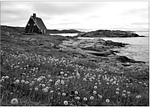Destination Greenland
A year and half ago photographer and Piermont resident Rena Bass Forman, her husband Scott Forman and Palisadian Milbry Polk conceived an expedition that would retrace 19th century painter William Bradford’s ambitious 1869 voyage to Greenland. Forman’s prior expeditions north, where she carried the flag of the not-for-profit Wings WorldQuest founded by Polk, were entitled Chasing the Light. This Greenlandic expedition, Chasing the Light, would focus on documenting the changes in landscape that Greenland has undergone since Bradford’s day through art, interviews and observation.
Rena, Milbry and Scott visited the New Bedford Whaling Museum in Massachusetts to see its extensive Bradford collection and enlist the museum as collaborator in the venture. Photographic curator Michael Lapides who joined the expedition, created a stellar online blog and wiki dedicated to Bradford. Lapides is now planning an exhibit focused on Bradford and the results of the recent expedition.
For his 19th century expedition, William Bradford hired professional photographers John L. Dunmore and George Critcherson to document the voyage; he used these photographs along with his sketches for large-scale paintings back in his studio as well as for a book, The Arctic Regions: Illustrated with Photographs Taken on an Art Expedition to Greenland, today considered a landmark in the history of photographically illustrated books. The New Bedford Whaling Museum, thanks to the generous support of Arctic historian and collector Bruce Wilburn, is republishing this classic.
Sadly, in November 2011, Rena died of a brain tumor in the midst of planning the expedition. Her daughter Zaria Forman, an artist, then joined Polk as co-leader. Polk has written and edited numerous books on exploration and has had her photographs exhibited in a variety of art shows. Because of the exploratory and investigative nature of the expedition, she enabled the expedition to carry flags of The Explorers Club, The Royal Canadian Geographical Society and Wings WorldQuest.
On August 4, 2012, the expedition gathered in Aasiaat, northwest Greenland, a town 120 miles north of the Arctic Circle. The ten team members were comprised of a writer, a videographer, a sound artist, two painters, a museum curator, a representative of the Greenland government and the Climate Change Center, an educator and photographers. The plan was to head as far north as the ice would allow paying especial attention to the places visited by Bradford in 1869.
After a week, the group split in two with five artists staying aboard the boat hired for the expedition and the rest going by small boat as far north as possible to reach remote settlements and ascertain the impact of climate change. The northern group was able to film a number of interviews with hunters and talk to the people about the almost complete absence of ice in this remote region. This area is now opening up to oil and mineral exploration, which will further impact the region. Altogether, the two parts of the expedition visited many of the places documented by the Bradford expedition.
“Bradford wrote about one settlement north of Upernavik that was so ice choked they had to tie the ship to an iceberg more than a mile away then navigate the ice in a small boat to reach land,” Milbry recounts. “When we passed by 143 years later, at the same time of year, there was no ice in sight. This change has a little known but important impact - no longer able to use dogs and sleds to hunt and fish from the ice - the land-locked Greenlanders are dependent on the few hunters who have managed to buy small boats and gas to get food for the community.”
The exhibition at the New Bedford Whaling Museum showcasing William Bradford’s paintings, Rena Bass Forman’s photographs and art created on the Greenland trip will be held in the spring of 2013. Lamont-Doherty's website notes: Arctic heat tops 1,800-year high, says a new study in the journal Geology.
Summers on the Norwegian archipelago of Svalbard are now warmer than at any other time in the last 1,800 years, including the naturally driven Medieval Warm Period, from about 950 to 1250, when parts of the northern hemisphere were as hot or hotter than today, according to a new study. This period has been a favorite time for people who deny evidence that humans are heating the planet with industrial greenhouse gases. Climate reconstruction from Svalbard undercuts these skeptics. Recent temperature measurements show that the Arctic is warming twice as fast as the rest of the planet. For more information go to the Lamont website, www.ldeo.columbia.edu/news




